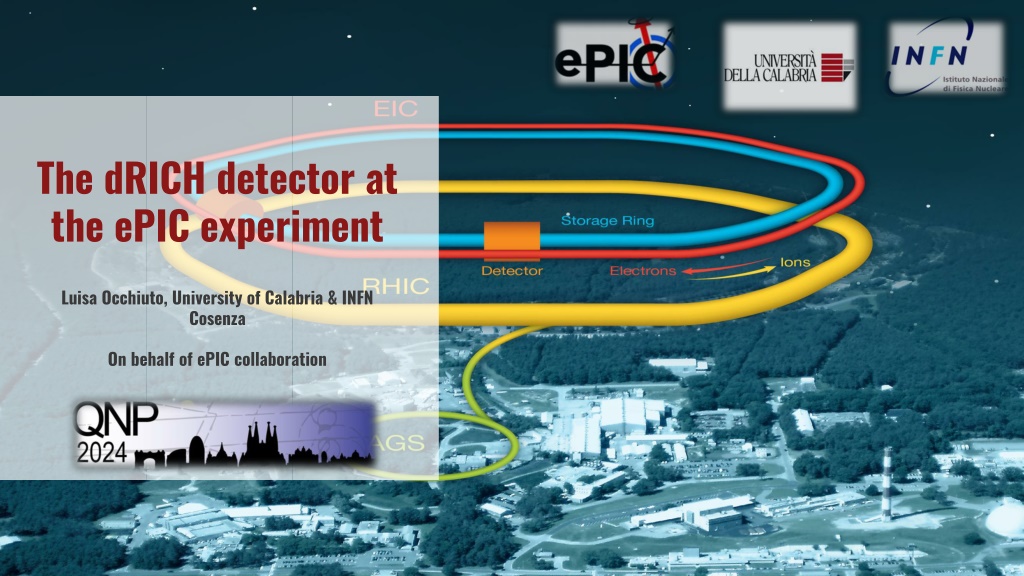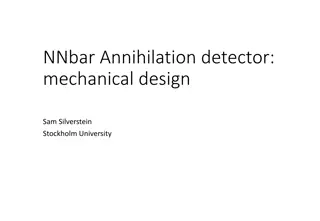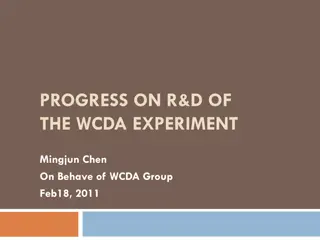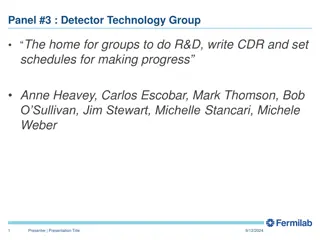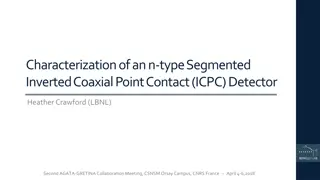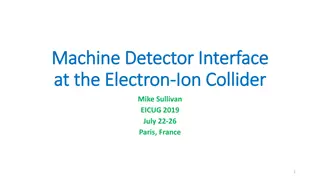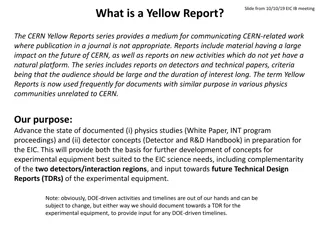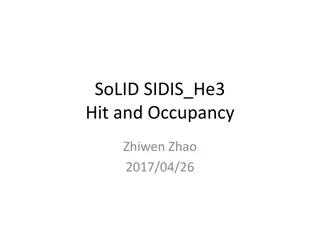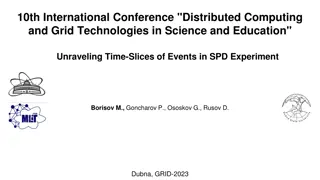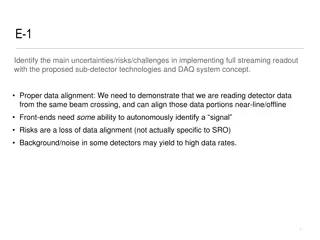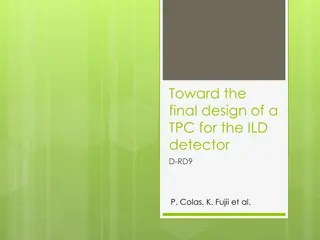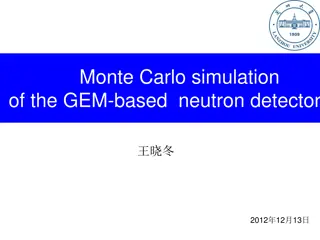Performance Studies of dRICH Detector at ePIC Experiment
"The Electron-Ion Collider ePIC experiment focuses on the performance studies of the dRICH detector for particle identification crucial in various physics channels. The detector features aerogel optimization, SiPM sensors, and test-beam analyses. Key capabilities include different techniques for particle tracking and identification as well as requirements for particle separation at various momenta. The implementation of the dRICH detector with dual radiators and SiPM sensors for forward particle identification up to 50GeV/c momentum coverage showcases the innovation in the field. Collaborative efforts by Luisa Occhiuto from the University of Calabria and INFN Cosenza contribute significantly to the ePIC collaboration."
Download Presentation

Please find below an Image/Link to download the presentation.
The content on the website is provided AS IS for your information and personal use only. It may not be sold, licensed, or shared on other websites without obtaining consent from the author. Download presentation by click this link. If you encounter any issues during the download, it is possible that the publisher has removed the file from their server.
E N D
Presentation Transcript
The dRICH detector at the ePIC experiment Luisa Occhiuto, University of Calabria & INFN Cosenza On behalf of ePIC collaboration
Introduction: The Electron-Ion Collider ePICexperiment dRICHdetector Performance studies Aerogel Optimization SiPMsensors Test-beam Summary THE ELECTRON-ION COLLIDER Collision of polarizedbeam of electron andlight nucleiorheavynucleiuptoU. HighLuminosity 1034?? 2? 1. Spanning over wide in COM energy 20-140 GeV; Twopossibleinteractionpoint. e J e L* (Q2) x+ x- ~ ~ H, H, E, E (x, ,t) p p t Semi-Inclusive DIS Exclusive Reactions Inclusive DIS Particleidentificationiscrucialfor severalphysicschannels! https://doi.org/10.1016/j.nuclphysa.2022.122447 luisa.occhiuto@cern.ch QNP2024 1
Introduction: The Electron-Ion Collider ePICexperiment dRICHdetector Performance studies Aerogel Optimization SiPMsensors Test-beam Summary THE ePIC EXPERIMENT luisa.occhiuto@cern.ch QNP2024 2
Introduction: The Electron-Ion Collider ePICexperiment dRICHdetector Performance studies Aerogel Optimization SiPMsensors Test-beam Summary THE ePIC EXPERIMENT ?/Kseparationrequirements: Backward pfRICH Upto9GeV/c Central hpDIRC + ToF Upto6GeV/c Forward dRICH + ToF Upto50GeV/c Particle tracking and identification (PID), aiming to separate electrons frompions,kaonsandprotons. KEYCAPABILITY Different techniques for PID adopted in theePICdetectorareshown luisa.occhiuto@cern.ch QNP2024 3
Introduction: The Electron-Ion Collider ePICexperiment dRICHdetector Performance studies Aerogel Optimization SiPMsensors Test-beam Summary dRICH SCHEMATIC IP6 luisa.occhiuto@cern.ch QNP2024 4
Introduction: The Electron-Ion Collider ePICexperiment dRICHdetector Performance studies Aerogel Optimization SiPMsensors Test-beam Summary FORWARD PARTICLE IDENTIFICATION (dRICH) Requirements: Highmomentumcoverageupto50GeV/c -K Dualradiator(aerogel(n~1.02)+C2F6gas(n~1.0008)) Wideacceptance(+-300mrad/1.5<? <3.5) Largesensorsurfacetobecoveredinmagneticfield: Limitedchoiceofphoton-sensor(SiPMasacosteffectivesolution) Aerogel Gas luisa.occhiuto@cern.ch QNP2024 5
Introduction: The Electron-Ion Collider ePICexperiment dRICHdetector Performance studies Aerogel Optimization SiPMsensors Test-beam Summary DD4HEP GEOMETRY DETAILS Sphericalmirrorwithradius220cm 6azimuthalsectors Aerogel 4cm radius110cm SiPMsensorstiledonspheres realistic PDE and additional 70%safetyfactor C2F6 GasVolume 120cm(full)z-lenght luisa.occhiuto@cern.ch QNP2024 6
Introduction: The Electron-Ion Collider ePICexperiment dRICHdetector Performance studies Aerogel Optimization SiPMsensors Test-beam Summary PERFORMANCE STUDIES dRICH N separation in function of momentum N? N? N? Momentum [GeV/c] Momentum [GeV/c] Momentum [GeV/c] @ >2.5 we achieve 3 with ??GeV/c of momentum for the aerogel and ?? GeV/c for the gas. luisa.occhiuto@cern.ch QNP2024 7
Introduction: The Electron-Ion Collider ePICexperiment dRICHdetector Performance studies Aerogel Optimization SiPMsensors Test-beam Summary PERFORMANCE STUDIES dRICH A E R O G E L 2.0 < ? > 2.5 G A S 2.0 < ? > 2.5 Resolution of Cerenkov angle 2.0 < ? > 2.5 2.0 < ? > 2.5 luisa.occhiuto@cern.ch QNP2024 8
Introduction: The Electron-Ion Collider ePICexperiment dRICHdetector Performance studies Aerogel Optimization SiPMsensors Test-beam Summary LOOK-UP TABLES (LUT) TheseprovideawaytoreconstructPIDbeforehavingfullreconstructionincludedinthesoftware Themethodologyisthefollowing: 01: 02: 03: Final identified to the corresponding probability particle according is LUTs give the probability, atafixedmomentumandat fixed ? , the dRICH has correctly identified particle A particle is simulated with acertainmomentumand? the luisa.occhiuto@cern.ch QNP2024 9
Introduction: The Electron-Ion Collider ePICexperiment dRICHdetector Performance studies Aerogel Optimization SiPMsensors Test-beam Summary LOOK-UP TABLES (LUT) AEROGEL ? K ? P ? ? ??,? 95% efficiencyof pionidentification formmomentum> 12.5 GeV/c !! K ? K K K P ??,? P ? P K P P ??,? Momentum [GeV/c] Momentum [GeV/c] Momentum [GeV/c] luisa.occhiuto@cern.ch QNP2024 10
Introduction: The Electron-Ion Collider ePICexperiment dRICHdetector Performance studies Aerogel Optimization SiPMsensors Test-beam Summary LOOK-UP TABLES (LUT) GAS ? K ? P ? ? K P K ? K K P ? P K P P luisa.occhiuto@cern.ch QNP2024 11
Introduction: The Electron-Ion Collider ePICexperiment dRICHdetector Performance studies Aerogel Optimization SiPMsensors Test-beam Summary REQUIREMENTS FOR AEROGEL AND FOR THE GAS Allstudies done with nominal aerogel. Nowwe needto optimizeit! Sigma = 0.45 mrad Sigma = 0.45 mrad Sigma = 0.75 mrad Type-1 (n=1.026) Type-2 (n=1.03) Baseline Higherrefractiveindex = higherphotonyield In order to achieve at least a 3 pion/Kaon separation above 50 GeV/c we need a ???? ?????????? ( ??? ???) around 0.3 mrad. luisa.occhiuto@cern.ch QNP2024 12
Introduction: The Electron-Ion Collider ePICexperiment dRICHdetector Performance studies Aerogel Optimization SiPMsensors Test-beam Summary Performance Comparison of Aerogel Type-1 (n=1.026) Gain in performance (wrtbaseline), 3.5-4 GeV/c more! Significantlylargernumberofphotons, 1.5timesmoreNph! luisa.occhiuto@cern.ch QNP2024 13
Introduction: The Electron-Ion Collider ePICexperiment dRICHdetector Performance studies Aerogel Optimization SiPMsensors Test-beam Summary Performance Comparison of Aerogel Type-2 (n=1.03) Better optical properties Higher refractive index Improved separation +, =0, =2.0 @ =2.0 we achieve 3 with ??GeV/c of momentum for the aerogel. luisa.occhiuto@cern.ch QNP2024 14
Introduction: The Electron-Ion Collider ePICexperiment dRICHdetector Performance studies Aerogel Optimization SiPMsensors Test-beam Summary SiPM SENSORS PRO Single photondetection; High PhotonDetectionEfficiency; Good time resolution; Insensitivetomagneticfield. Cheap Low voltageoperation HAMA S13360-3050 HAMA S13360-3075 CONS: LargeDarkCountRate Prone toradiationdamage HAMA S14160-3050 Expected DCR 300 kHz for each SiPMchannel. Time window of probabilityofhitnoiseper 1ns. Expected noise hits ??? per eventin3 105SiPMssystem 1 ns 3 10 4 Forfurtherdetailspayattention at Pietro Antonioli stalk! luisa.occhiuto@cern.ch QNP2024 15
Introduction: The Electron-Ion Collider ePICexperiment dRICHdetector Performance studies Aerogel Optimization SiPMsensors Test-beam Summary TEST BEAM @ CERN Reconstructed radii at 10 GeV/c with no selection applied P ?+ ?+ 10 GeV/c positive beam with no selection applied Hamamatsu S13360-3050 Hamamatsu S13360-3075 luisa.occhiuto@cern.ch QNP2024 16
Introduction: The Electron-Ion Collider ePICexperiment dRICHdetector Performance studies Aerogel Optimization SiPMsensors Test-beam Summary dRICH @ ePIC experiment SUMMARY 1. ThedRICHiscapableof3 ?/Kseparationslightlyabovethan 50GeV/cintheforwardregion. Emission point uncertainty enhances due to spherical aberrationinthelowerrapidity,PIDlimitedto35GeV/c. The aerogel with a refractive index of n=1.026 produces a greater NPE compared totheaerogel with n=1.02and provides betterresolutionat3 . LUTsconsistentwithN separationresults. 2. 3. 4. Studiesongoing: a. Several studies on the optimization of aerogel. b. New LUTs. c. Reconstructionalgorithm. d. Analysisfromthetestbeam@CERN. References: o https://agenda.infn.it/event/34631/contributions/202597/attach ments/107489/151768/chchatte_eic_net.pdf o https://indico.bnl.gov/event/17621/contributions/70624/subcont ributions/2121/attachments/45449/76684/dilks__drich.pdf luisa.occhiuto@cern.ch QNP2024 17
THANKS! luisa.occhiuto@cern.ch QNP2024 18
Backup luisa.occhiuto@cern.ch QNP2024 19
PERFORMANCE STUDIES dRICH A E R O G E L 1.5 < ? > 2.0 2.0 < ? > 2.5 2.5 < ? > 3.5 1.5 < ? > 2.0 2.0 < ? > 2.5 2.5 < ? > 3.5 luisa.occhiuto@cern.ch QNP2024 20
PERFORMANCE STUDIES dRICH 2.0 < ? > 2.5 2.5 < ? > 3.5 G A S 1.5 < ? > 2.0 1.5 < ? > 2.0 2.0 < ? > 2.5 2.5 < ? > 3.5 luisa.occhiuto@cern.ch QNP2024 21
Performance Comparison of new Aerogel Type-1 (n=1.026) New type-1 Aerogel provides ring resolution capable to perform PID ~ 18-19 GeV (@eta=2.0), baseline aerogel is limited only upto 15-16 GeV luisa.occhiuto@cern.ch QNP2024 22
Introduction: The Electron-Ion Collider ePICexperiment dRICHdetector Performance studies Aerogel Optimization SiPMsensors Test-beam Summary Performance Comparison of Aerogel Type-2 (n=1.03) Pseudorapidity is seen also for type-2 aerogel forfixedazimuthalangle dependency luisa.occhiuto@cern.ch QNP2024 23
Performance: N Separation of Aerogel Type-2 (n=1.03) luisa.occhiuto@cern.ch QNP2024 24
COMPARISON SPE TYPE-1 vs TYPE-2 Type-1 Baseline ? ?.?mrad ? ?.??mrad Type-2 ? ?.??mrad luisa.occhiuto@cern.ch QNP2024 25
COMPARISON SPE TYPE-1 vs TYPE-2 Type-1 Baseline ? ?.?mrad ? ?.??mrad Type-2 ? ?.??mrad luisa.occhiuto@cern.ch QNP2024 25
Performance: NPE and Resolution vs of Aerogel Type-2 (n=1.03) luisa.occhiuto@cern.ch QNP2024 26
